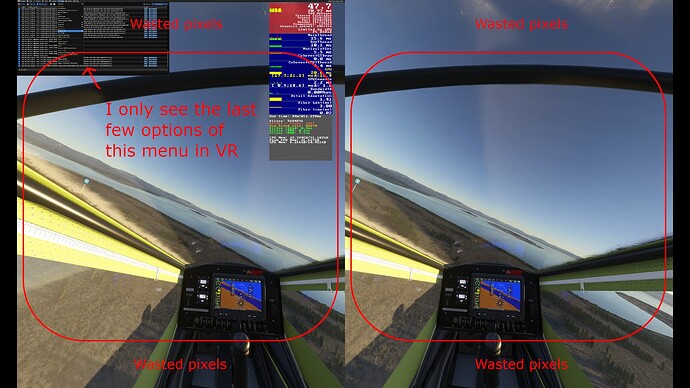 SIM INFORMATION
SIM INFORMATION
This is vital information for our test team, please do not skip it or your issue may not be able to be reproduced or fixed.
-
Microsoft Flight Simulator 2020 or 2024: 2024
-
Version Build Number (Where do I locate that?): 1.1.7.0
-
Game Platform (Exampe: Steam, Xbox, MS Store): MS Store
 ISSUE DESCRIPTION
ISSUE DESCRIPTION
- Description of the issue:
I’ve been seeing a lot of people on this forum say that the performance of MSFS 2024 is about half of 2020, and I can say I have experienced the same.
However, I have found a potential cause for this, and it’s because the game is not rendering at the headset’s proper resolution and aspect ratio! In fact, it seems 30% of the pixels being rendered right now can’t even be seen in the headset! Please see the image below where I show what I actually see in the headset VS what is being rendered.
iirc MSFS 2020 had a similar problem, but was solved shortly after VR support was released. Quite an embarrassment that they made the same mistake again! This clearly shows that VR support was just an afterthought for 2024 and it’s a shame to see.
- Did you remove all your community mods/add-ons? If yes, are you still experiencing the issue? Yes
 FREQUENCY OF ISSUE
FREQUENCY OF ISSUE
How often does this occur for you? (Example: Just once, every time on sim load, intermittently) All the time
 REPRODUCTION STEPS
REPRODUCTION STEPS
Please list clear steps you took in order to help our test team reproduce the same issue.
- Play in VR
 YOUR SETTINGS
YOUR SETTINGS
If the issue still occurs with no mods and add-ons, please continue to report your issue. If not, please move this post to the User Support Hub.
-
What peripherals are you using, if relevant: Pimax Crystal
-
[PC Only] Are you using Developer Mode or have you made any changes to it? Yes, no changes.
-
[PC, MSFS 2020 Only] Are you using DX11 or DX12?
-
[PC Only] Many issues may be due to an outdated graphics card. Please state your Graphics Card Driver Manufacturer (NVIDIA, Intel, AMD) and Version (Learn how to find your current graphics card driver version): RTX 4080 Super
-
[PC Only] What other relevant PC specs can you share? Ryzen 9 7950X3D GPU
 MEDIA
MEDIA
Please add a screenshot or video of the issue occurring.
This is how it should look. Click the link below to view the image:
[END OF FIRST USER REPORT]
![]() For anyone who wants to contribute on this issue, Click on the button below to use this template:
For anyone who wants to contribute on this issue, Click on the button below to use this template:
Do you have the same issue if you follow the OP’s steps to reproduce it?
•
Provide extra information to complete the original description of the issue:
•
If relevant, provide additional screenshots/video:
•
